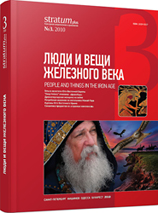Погребальные сооружения и обряд Перещепинского некрополя
Burial Structures and Rite of the Pereshchepino Barrow Cemetery
Author(s): Serghei V. MakhortykhSubject(s): History, Archaeology, Ancient World
Published by: Издательский дом Stratum, Университет «Высшая антропологическая школа»
Keywords: Poltava region; barrow cemetery Pereshchepino; 5 th — 4 th cc. BC
Summary/Abstract: The article is dedicated to the analysis of the funeral rite of the Pereshchepino barrow cemetery, located to the west from the village of Belsk in the Poltava region. This monument is the best studied burial ground, which is situated near the famous Belsk hillfort of the Scythian Age.Remains of more than 50 deceased were found in 39 barrows, the majority of which were dated to the 5 th —early 4 th century BC. Male burials were dominant — 23 interments, while female and children/juvenile burials were fewer — fifteen in each category. Significant number of paired and common interments should be mentioned (79%). In the same time, individual burials were a minority (21%).Ground pits dominated among burial constructions (27—64%). Among them, rectangular pits were the most common (16—38%), followed by almost square graves (6—14%). More “complicated” burial structures were represented by wooden charnels (6—14%). Constructions from earth and wood in the form of srub represented a specific feature of Pereshchepino burial ground — 9 (22%). Some other distinctive characteristics should be also mentioned: wide use of funeral feasts; changing ritual actions, related to the use of fire; use of barrow mounds to house just one burial with some exceptional appearances of secondary burials in elite barrows; predominance of burials in simple ground pits with a wooden cover; wooden flooring on the bottom of the graves placed on special grooves; orientation of burial constructions on the line north-east–south-west and north-south; prevalence of inhumations stretched on the back, with some rare cases of flexed position; a variety of orientations of skeletons, among which the northern, eastern, western and south-western directions were dominant; a small number of individual burials with considerable predominance of paired and common interments; accompanying burials of servants.
Journal: Stratum plus. Археология и культурная антропология
- Issue Year: 2010
- Issue No: 3
- Page Range: 215-235
- Page Count: 21
- Language: Russian

